+ Open data
Open data
- Basic information
Basic information
| Entry | Database: PDB / ID: 1i09 | ||||||
|---|---|---|---|---|---|---|---|
| Title | STRUCTURE OF GLYCOGEN SYNTHASE KINASE-3 (GSK3B) | ||||||
 Components Components | GLYCOGEN SYNTHASE KINASE-3 BETA | ||||||
 Keywords Keywords | TRANSFERASE / kinase / beta barrel | ||||||
| Function / homology |  Function and homology information Function and homology informationneuron projection organization / regulation of microtubule anchoring at centrosome / negative regulation of type B pancreatic cell development / negative regulation of glycogen (starch) synthase activity / negative regulation of mesenchymal stem cell differentiation / superior temporal gyrus development / positive regulation of protein localization to cilium / negative regulation of glycogen biosynthetic process / negative regulation of TORC2 signaling / negative regulation of dopaminergic neuron differentiation ...neuron projection organization / regulation of microtubule anchoring at centrosome / negative regulation of type B pancreatic cell development / negative regulation of glycogen (starch) synthase activity / negative regulation of mesenchymal stem cell differentiation / superior temporal gyrus development / positive regulation of protein localization to cilium / negative regulation of glycogen biosynthetic process / negative regulation of TORC2 signaling / negative regulation of dopaminergic neuron differentiation / maintenance of cell polarity / positive regulation of protein localization to centrosome / positive regulation of cilium assembly / CRMPs in Sema3A signaling / heart valve development / tau-protein kinase / beta-catenin destruction complex / APC truncation mutants have impaired AXIN binding / AXIN missense mutants destabilize the destruction complex / Truncations of AMER1 destabilize the destruction complex / regulation of protein export from nucleus / positive regulation of mitochondrial outer membrane permeabilization involved in apoptotic signaling pathway / Beta-catenin phosphorylation cascade / Signaling by GSK3beta mutants / CTNNB1 S33 mutants aren't phosphorylated / CTNNB1 S37 mutants aren't phosphorylated / CTNNB1 S45 mutants aren't phosphorylated / CTNNB1 T41 mutants aren't phosphorylated / cellular response to interleukin-3 / Maturation of nucleoprotein / Wnt signalosome / regulation of long-term synaptic potentiation / negative regulation of TOR signaling / regulation of microtubule-based process / negative regulation of protein localization to nucleus / AKT phosphorylates targets in the cytosol / Disassembly of the destruction complex and recruitment of AXIN to the membrane / negative regulation of calcineurin-NFAT signaling cascade / regulation of axon extension / Maturation of nucleoprotein / tau-protein kinase activity / negative regulation of epithelial to mesenchymal transition / regulation of axonogenesis / positive regulation of cell-matrix adhesion / regulation of dendrite morphogenesis / G protein-coupled dopamine receptor signaling pathway / glycogen metabolic process / ER overload response / regulation of neuron projection development / Constitutive Signaling by AKT1 E17K in Cancer / protein kinase A catalytic subunit binding / establishment of cell polarity / dynactin binding / epithelial to mesenchymal transition / Regulation of HSF1-mediated heat shock response / canonical Wnt signaling pathway / NF-kappaB binding / negative regulation of osteoblast differentiation / positive regulation of protein binding / negative regulation of protein-containing complex assembly / negative regulation of extrinsic apoptotic signaling pathway via death domain receptors / regulation of cellular response to heat / extrinsic apoptotic signaling pathway / cellular response to retinoic acid / extrinsic apoptotic signaling pathway in absence of ligand / positive regulation of autophagy / presynaptic modulation of chemical synaptic transmission / Transcriptional and post-translational regulation of MITF-M expression and activity / regulation of microtubule cytoskeleton organization / negative regulation of cell migration / response to endoplasmic reticulum stress / positive regulation of protein export from nucleus / positive regulation of protein ubiquitination / Ubiquitin-dependent degradation of Cyclin D / excitatory postsynaptic potential / hippocampus development / mitochondrion organization / positive regulation of cell differentiation / positive regulation of protein-containing complex assembly / GSK3B and BTRC:CUL1-mediated-degradation of NFE2L2 / negative regulation of canonical Wnt signaling pathway / Degradation of GLI2 by the proteasome / GLI3 is processed to GLI3R by the proteasome / circadian rhythm / regulation of circadian rhythm / beta-catenin binding / peptidyl-serine phosphorylation / Degradation of beta-catenin by the destruction complex / B-WICH complex positively regulates rRNA expression / tau protein binding / Wnt signaling pathway / cellular response to amyloid-beta / neuron projection development / Regulation of RUNX2 expression and activity / positive regulation of protein catabolic process / p53 binding / kinase activity / insulin receptor signaling pathway / positive regulation of proteasomal ubiquitin-dependent protein catabolic process / positive regulation of neuron apoptotic process Similarity search - Function | ||||||
| Biological species |  Homo sapiens (human) Homo sapiens (human) | ||||||
| Method |  X-RAY DIFFRACTION / X-RAY DIFFRACTION /  MOLECULAR REPLACEMENT / Resolution: 2.7 Å MOLECULAR REPLACEMENT / Resolution: 2.7 Å | ||||||
 Authors Authors | Ter Haar, E. / Coll, J.T. / Jain, J. | ||||||
 Citation Citation |  Journal: Nat.Struct.Biol. / Year: 2001 Journal: Nat.Struct.Biol. / Year: 2001Title: Structure of GSK3beta reveals a primed phosphorylation mechanism. Authors: ter Haar, E. / Coll, J.T. / Austen, D.A. / Hsiao, H.M. / Swenson, L. / Jain, J. | ||||||
| History |
| ||||||
| Remark 999 | SEQUENCE The authors have analyzed the GSK3b sequences (expressed sequence tags databases) ...SEQUENCE The authors have analyzed the GSK3b sequences (expressed sequence tags databases) carefully and came to the conclusion that there is an error in P49841 sequence. HIS 350 should be a LEU. It is definitely a LEU in crystal structure sequence. |
- Structure visualization
Structure visualization
| Structure viewer | Molecule:  Molmil Molmil Jmol/JSmol Jmol/JSmol |
|---|
- Downloads & links
Downloads & links
- Download
Download
| PDBx/mmCIF format |  1i09.cif.gz 1i09.cif.gz | 132.7 KB | Display |  PDBx/mmCIF format PDBx/mmCIF format |
|---|---|---|---|---|
| PDB format |  pdb1i09.ent.gz pdb1i09.ent.gz | 105.5 KB | Display |  PDB format PDB format |
| PDBx/mmJSON format |  1i09.json.gz 1i09.json.gz | Tree view |  PDBx/mmJSON format PDBx/mmJSON format | |
| Others |  Other downloads Other downloads |
-Validation report
| Summary document |  1i09_validation.pdf.gz 1i09_validation.pdf.gz | 394.5 KB | Display |  wwPDB validaton report wwPDB validaton report |
|---|---|---|---|---|
| Full document |  1i09_full_validation.pdf.gz 1i09_full_validation.pdf.gz | 418 KB | Display | |
| Data in XML |  1i09_validation.xml.gz 1i09_validation.xml.gz | 17.8 KB | Display | |
| Data in CIF |  1i09_validation.cif.gz 1i09_validation.cif.gz | 26.3 KB | Display | |
| Arichive directory |  https://data.pdbj.org/pub/pdb/validation_reports/i0/1i09 https://data.pdbj.org/pub/pdb/validation_reports/i0/1i09 ftp://data.pdbj.org/pub/pdb/validation_reports/i0/1i09 ftp://data.pdbj.org/pub/pdb/validation_reports/i0/1i09 | HTTPS FTP |
-Related structure data
| Similar structure data |
|---|
- Links
Links
- Assembly
Assembly
| Deposited unit | 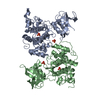
| ||||||||
|---|---|---|---|---|---|---|---|---|---|
| 1 | 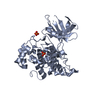
| ||||||||
| 2 | 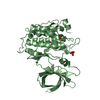
| ||||||||
| Unit cell |
|
- Components
Components
| #1: Protein | Mass: 46801.215 Da / Num. of mol.: 2 Source method: isolated from a genetically manipulated source Source: (gene. exp.)  Homo sapiens (human) / Production host: Homo sapiens (human) / Production host:  unidentified baculovirus / References: UniProt: P49841, EC: 2.7.1.37 unidentified baculovirus / References: UniProt: P49841, EC: 2.7.1.37#2: Chemical | ChemComp-PO4 / #3: Water | ChemComp-HOH / | |
|---|
-Experimental details
-Experiment
| Experiment | Method:  X-RAY DIFFRACTION X-RAY DIFFRACTION |
|---|
- Sample preparation
Sample preparation
| Crystal | Density Matthews: 3.43 Å3/Da / Density % sol: 64.13 % | ||||||||||||||||||||||||||||||
|---|---|---|---|---|---|---|---|---|---|---|---|---|---|---|---|---|---|---|---|---|---|---|---|---|---|---|---|---|---|---|---|
| Crystal grow | Temperature: 277 K / Method: vapor diffusion, hanging drop / pH: 4.1 Details: PEG 3350 Na/K Phosphate DTT, pH 4.1, VAPOR DIFFUSION, HANGING DROP, temperature 277K | ||||||||||||||||||||||||||||||
| Crystal grow | *PLUS | ||||||||||||||||||||||||||||||
| Components of the solutions | *PLUS
|
-Data collection
| Radiation | Protocol: SINGLE WAVELENGTH / Monochromatic (M) / Laue (L): M / Scattering type: x-ray |
|---|---|
| Radiation wavelength | Relative weight: 1 |
| Reflection | Resolution: 2.7→48.31 Å / Num. all: 35382 / Num. obs: 34747 / % possible obs: 96 % / Redundancy: 4 % / Biso Wilson estimate: 34.9 Å2 / Rmerge(I) obs: 0.07 / Net I/σ(I): 19 |
| Reflection shell | Resolution: 2.7→2.8 Å / Redundancy: 4 % / Rmerge(I) obs: 0.322 / % possible all: 99.8 |
| Reflection | *PLUS Num. obs: 34993 / % possible obs: 98.9 % / Num. measured all: 251279 / Rmerge(I) obs: 0.07 |
| Reflection shell | *PLUS % possible obs: 99.8 % / Rmerge(I) obs: 0.32 / Mean I/σ(I) obs: 4.5 |
- Processing
Processing
| Software |
| ||||||||||||||||||||||||||||||
|---|---|---|---|---|---|---|---|---|---|---|---|---|---|---|---|---|---|---|---|---|---|---|---|---|---|---|---|---|---|---|---|
| Refinement | Method to determine structure:  MOLECULAR REPLACEMENT / Resolution: 2.7→48.3 Å / σ(F): 0 / Stereochemistry target values: Engh & Huber MOLECULAR REPLACEMENT / Resolution: 2.7→48.3 Å / σ(F): 0 / Stereochemistry target values: Engh & Huber
| ||||||||||||||||||||||||||||||
| Refinement step | Cycle: LAST / Resolution: 2.7→48.3 Å
| ||||||||||||||||||||||||||||||
| LS refinement shell | Resolution: 2.7→2.87 Å / Rfactor Rfree error: 0.016
| ||||||||||||||||||||||||||||||
| Software | *PLUS Name: CNX / Classification: refinement | ||||||||||||||||||||||||||||||
| Refinement | *PLUS Highest resolution: 2.7 Å / Lowest resolution: 48.3 Å / σ(F): 0 / % reflection Rfree: 9.1 % / Rfactor obs: 0.237 | ||||||||||||||||||||||||||||||
| Solvent computation | *PLUS | ||||||||||||||||||||||||||||||
| Displacement parameters | *PLUS | ||||||||||||||||||||||||||||||
| Refine LS restraints | *PLUS
| ||||||||||||||||||||||||||||||
| LS refinement shell | *PLUS Highest resolution: 2.7 Å / Rfactor Rfree: 0.352 / Rfactor Rwork: 0.325 |
 Movie
Movie Controller
Controller



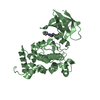




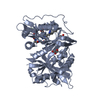
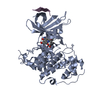


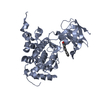
 PDBj
PDBj









